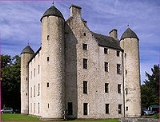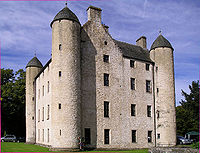
Methven Castle
Encyclopedia

Methven, Perth and Kinross
Methven is a large village in the Scottish region of Perth and Kinross, on the A85 road due west of the town of Perth. Methven is close to another Perthshire village, Almondbank...
, in Perth and Kinross
Perth and Kinross
Perth and Kinross is one of 32 council areas in Scotland, and a Lieutenancy Area. It borders onto the Aberdeenshire, Angus, Dundee City, Fife, Clackmannanshire, Stirling, Argyll and Bute and Highland council areas. Perth is the administrative centre...
, Scotland
Scotland
Scotland is a country that is part of the United Kingdom. Occupying the northern third of the island of Great Britain, it shares a border with England to the south and is bounded by the North Sea to the east, the Atlantic Ocean to the north and west, and the North Channel and Irish Sea to the...
.
History
The lands of Methven were owned by the Mowbray family from the 12th century. The Mowbrays supported the claim of John Balliol against Robert the Bruce, and on the latter's victory, Methven was confiscated by the crown, and given to Walter StewartWalter Stewart, 6th High Steward of Scotland
Walter Stewart was the 6th hereditary High Steward of Scotland. He was also the father of King Robert II of Scotland.-Biography:...
, the Bruce's son-in-law. His descendant, Walter Stewart, Earl of Atholl, was deprived of the lands following his involvement in a plot to kill King James I
James I of Scotland
James I, King of Scots , was the son of Robert III and Annabella Drummond. He was probably born in late July 1394 in Dunfermline as youngest of three sons...
. The castle sustained a siege in 1444, and was visited by King James II
James II of Scotland
James II reigned as King of Scots from 1437 to his death.He was the son of James I, King of Scots, and Joan Beaufort...
in 1450. King James IV
James IV of Scotland
James IV was King of Scots from 11 June 1488 to his death. He is generally regarded as the most successful of the Stewart monarchs of Scotland, but his reign ended with the disastrous defeat at the Battle of Flodden Field, where he became the last monarch from not only Scotland, but also from all...
visited several times in the 1490s.
Methven Castle was the home of Margaret Tudor
Margaret Tudor
Margaret Tudor was the elder of the two surviving daughters of Henry VII of England and Elizabeth of York, and the elder sister of Henry VIII. In 1503, she married James IV, King of Scots. James died in 1513, and their son became King James V. She married secondly Archibald Douglas, 6th Earl of...
(1489-1541), queen of James IV
James IV of Scotland
James IV was King of Scots from 11 June 1488 to his death. He is generally regarded as the most successful of the Stewart monarchs of Scotland, but his reign ended with the disastrous defeat at the Battle of Flodden Field, where he became the last monarch from not only Scotland, but also from all...
, King of Scots, and daughter of Henry VII of England
Henry VII of England
Henry VII was King of England and Lord of Ireland from his seizing the crown on 22 August 1485 until his death on 21 April 1509, as the first monarch of the House of Tudor....
, after her third marriage to Henry Stewart, 1st Lord Methven
Henry Stewart, 1st Lord Methven
Henry Stewart, 1st Lord Methven was Master of the Scottish Artillery and third husband of Margaret Tudor, eldest daughter of Henry VII of England and Elizabeth of York.-Ancient lineage:...
in 1528. Margaret Tudor died here on 18 October 1541. After the third Lord Methven died without heir in 1584, King James VI gave Methven to his favourite, the Duke of Lennox
Ludovic Stewart, 2nd Duke of Lennox
Ludovic Stewart, 2nd Duke of Lennox and 1st Duke of Richmond was a Scottish nobleman and politician. He was the son of Esmé Stewart, 1st Duke of Lennox and his wife Catherine de Balsac. Stewart was involved in the Plantation of Ulster in Ireland and the colonization of Maine in New England...
. In 1664 the estate was purchased by Patrick Smythe of Braco.
The present building is dated 1664, and was designed and built by the mason-architect John Mylne
John Mylne (1611-1667)
John Mylne , sometimes known as "John Mylne junior", or "the Younger", was a Scottish master mason and architect, who served as Master Mason to the Crown of Scotland. Born in Perth, he was the son of John Mylne, master mason, and Isobel Wilson.Practising as a stonemason, he also took on the role of...
. It may incorporate older work, The Smythe family remained in possession throughout the 18th and 19th centuries, making additions to the castle and the grounds. In 1923 the castle was sold, and changed hands several times until 1984, when restoration work began. The east wing was demolished, following the west wing which was pulled down in the 1950s, leaving only the 17th-century house, which was given a new roof. The castle remains in private ownership, and is a category A listed building.
Architecture
It comprises a square, four-storey main block, with narrow circular towers at each corner. These have ogeeOgee
An ogee is a curve , shaped somewhat like an S, consisting of two arcs that curve in opposite senses, so that the ends are parallel....
-shaped roofs, and the whole building is harl
Harl
Harling is a Scottish term describing an exterior building surfacing technique. The theory of harling is to produce a long-lasting weatherproof shield for a stone building. A pigment can be embedded in the harled material, thus obviating the need for repainting...
ed. The north front has a pair of crow-stepped gable
Crow-stepped gable
A Stepped gable, Crow-stepped gable, or Corbie step is a stair-step type of design at the top of the triangular gable-end of a building...
s, linked by a balustrade. An east wing was added first, then a western extension with a bay window
Bay window
A bay window is a window space projecting outward from the main walls of a building and forming a bay in a room, either square or polygonal in plan. The angles most commonly used on the inside corners of the bay are 90, 135 and 150 degrees. Bay windows are often associated with Victorian architecture...
, built around 1815, probably by James Gillespie Graham
James Gillespie Graham
James Gillespie Graham was a Scottish architect, born in Dunblane. He is most notable for his work in the Scottish baronial style, as at Ayton Castle, and he worked in the Gothic Revival style, in which he was heavily influenced by the work of Augustus Pugin...
. Graham produced designs for rebuilding the whole structure, but this was never carried out. The building also had a clock tower, but this was demolished around 1965. Inside, the building was remodelled in 1800, and only a stair remains of the original interiors.
Grounds
Parkland was laid out around the castle from the late 18th century. David Smythe, Lord Methven (d.1847), a judge, planted many of the woodlands, and a walled gardenWalled garden
A walled garden is specifically a garden enclosed by high walls for horticultural rather than security purposes, though traditionally all gardens have been hedged about or walled for protection from animal or human intruders...
was constructed in 1796. In 1830 a pinetum, an arboretum
Arboretum
An arboretum in a narrow sense is a collection of trees only. Related collections include a fruticetum , and a viticetum, a collection of vines. More commonly, today, an arboretum is a botanical garden containing living collections of woody plants intended at least partly for scientific study...
consisting of conifers, was established, and is considered the first in Scotland. David's son William continued to expand the estate and constructed glasshouses. Although the woodlands continued to be managed into the 20th century, the gardens were neglected and numerous trees felled, including much of the pinetum, in the 1950s. The largest surviving tree is the Pepperwell Oak, with a girth of 22 in 10 in (6.96 m), as measured in 1985. In 1883 this tree was thought to be already 400 years old. The parks and gardens are listed in the Inventory of Gardens and Designed Landscapes in Scotland, the national listing of significant gardens.

